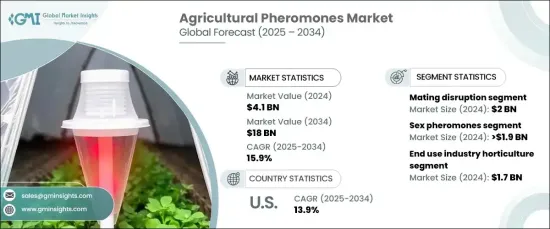PUBLISHER: Global Market Insights Inc. | PRODUCT CODE: 1665246

PUBLISHER: Global Market Insights Inc. | PRODUCT CODE: 1665246
Agricultural Pheromones Market Opportunity, Growth Drivers, Industry Trend Analysis, and Forecast 2025 - 2034
The Global Agricultural Pheromones Market reached USD 4.1 billion in 2024 and is projected to experience significant growth, with a CAGR of 15.9% from 2025 to 2034. This remarkable growth is driven by an increasing shift towards sustainable pest control methods. Agricultural pheromones, which are natural chemical signals used to attract or repel specific pests, provide an eco-friendly alternative to traditional chemical pesticides. These pheromones play a crucial role in mating disruption, pest monitoring, and insect trapping, particularly in the cultivation of fruits, vegetables, and grains.

In 2024, the sex pheromones segment accounted for USD 1.9 billion, with expectations for it to grow at a 16% CAGR through 2034. Sex pheromones are essential in pest control as they disrupt the mating behaviors of targeted pests by emitting chemicals that attract or confuse them. This makes them highly effective in managing pests such as moths, beetles, and fruit flies, which can cause significant damage to crops. The primary application of sex pheromones is mating disruption, wherein synthetic pheromones are released in large volumes to confuse pests, preventing successful mating and leading to a reduction in pest populations.
| Market Scope | |
|---|---|
| Start Year | 2024 |
| Forecast Year | 2025-2034 |
| Start Value | $4.1 Billion |
| Forecast Value | $18 Billion |
| CAGR | 15.9% |
The mating disruption technique emerged as the leading segment in the agricultural pheromones market, valued at USD 2 million in 2024. It is projected to expand at a CAGR of 16.1% between 2025 and 2034. Mating disruption plays a vital role in sustainable pest control practices, as it involves releasing synthetic pheromones to interfere with the mating activities of pests. This approach is highly effective in decreasing pest populations without causing harm to the environment or non-target species. Mating disruption is particularly beneficial for protecting crops like fruits, vegetables, and grains, offering numerous advantages such as reduced pesticide use, minimal environmental impact, and improved crop yields.
The U.S. agricultural pheromones market, valued at USD 990.9 million in 2024, is expected to grow at a robust CAGR of 13.9%. As one of the leading regions in the global market, the U.S. has seen widespread adoption of sustainable agricultural practices and innovative pest management solutions. This growth is further bolstered by increasing regulatory pressures to reduce pesticide use and the growing preference for organic farming. Additionally, the rising demand for precision agriculture technologies, such as IoT-based monitoring systems and drones, is driving enhanced pest control efficiency and effectiveness in the region.
Table of Contents
Chapter 1 Methodology & Scope
- 1.1 Market scope & definitions
- 1.2 Base estimates & calculations
- 1.3 Forecast calculations
- 1.4 Data sources
- 1.4.1 Primary
- 1.4.2 Secondary
- 1.4.2.1 Paid sources
- 1.4.2.2 Public sources
Chapter 2 Executive Summary
- 2.1 Industry synopsis, 2021-2034
Chapter 3 Industry Insights
- 3.1 Industry ecosystem analysis
- 3.1.1 Factor affecting the value chain
- 3.1.2 Profit margin analysis
- 3.1.3 Disruptions
- 3.1.4 Future outlook
- 3.1.5 Manufacturers
- 3.1.6 Distributors
- 3.2 Supplier landscape
- 3.3 Profit margin analysis
- 3.4 Key news & initiatives
- 3.5 Regulatory landscape
- 3.6 Impact forces
- 3.6.1 Growth drivers
- 3.6.1.1 Increasing demand for sustainable agriculture practices
- 3.6.1.2 Rising consumer preference for pesticide-free produce
- 3.6.1.3 Advancements in pheromone formulation technologies
- 3.6.2 Industry pitfalls & challenges
- 3.6.2.1 High production costs of pheromone-based products
- 3.6.1 Growth drivers
- 3.7 Growth potential analysis
- 3.8 Porter’s analysis
- 3.9 PESTEL analysis
Chapter 4 Competitive Landscape, 2024
- 4.1 Introduction
- 4.2 Company market share analysis
- 4.3 Competitive positioning matrix
- 4.4 Strategic outlook matrix
Chapter 5 Market Estimates & Forecast, By Type, 2021-2034 (USD Billion) (Kilo Tons)
- 5.1 Key trends
- 5.2 Sex pheromones
- 5.3 Aggregation pheromones
- 5.4 Alarm pheromones
- 5.5 Trail pheromones
- 5.6 Others
Chapter 6 Market Estimates & Forecast, By Mode of action, 2021-2034 (USD Billion) (Kilo Tons)
- 6.1 Key trends
- 6.2 Mating disruption
- 6.3 Mass trapping
- 6.4 Attract-and-kill
- 6.5 Monitoring and detection
- 6.6 Others
Chapter 7 Market Estimates & Forecast, By End Use, 2021-2034 (USD Billion) (Kilo Tons)
- 7.1 Key trends
- 7.2 Horticulture
- 7.3 Field crops
- 7.4 Others
Chapter 8 Market Estimates & Forecast, By Region, 2021-2034 (USD Billion) (Kilo Tons)
- 8.1 Key trends
- 8.2 North America
- 8.2.1 U.S.
- 8.2.2 Canada
- 8.3 Europe
- 8.3.1 UK
- 8.3.2 Germany
- 8.3.3 France
- 8.3.4 Italy
- 8.3.5 Spain
- 8.3.6 Russia
- 8.4 Asia Pacific
- 8.4.1 China
- 8.4.2 India
- 8.4.3 Japan
- 8.4.4 South Korea
- 8.4.5 Australia
- 8.5 Latin America
- 8.5.1 Brazil
- 8.5.2 Mexico
- 8.6 MEA
- 8.6.1 South Africa
- 8.6.2 Saudi Arabia
- 8.6.3 UAE
Chapter 9 Company Profiles
- 9.1 Suterra
- 9.2 BASF SE
- 9.3 BedoukianBio (part of Bedoukian Research)
- 9.4 Biobest Group NV
- 9.5 Corteva Agriscience
- 9.6 FMC Corporation
- 9.7 ISCA Technologies
- 9.8 Pherobank
- 9.9 Russell IPM
- 9.10 Scyll'agro
- 9.11 Shin-Etsu Chemical
- 9.12 Trece




